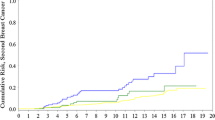Abstract
We searched for criteria that could indicate breast cancer families with a high prior probability of being caused by the breast/ovarian cancer susceptibility locus BRCA1 on chromosome 17. To this end, we performed a linkage study with 59 consecutively collected Dutch breast cancer families, including 16 with at least one case of ovarian cancer. We used an intake cut-off of at least three first-degree relatives with breast and/or ovarian cancer at any age. Significant evidence for linkage was found only among the 13 breast cancer families with a mean age at diagnosis of less than 45 years. An unexpectedly low proportion of the breast-ovarian cancer families were estimated to be linked to BRCA1, which could be due to a founder effect in the Dutch population. Given the expected logistical problems in clinical management now that BRCA1 has been identified, we propose an interim period in which only families with a strong positive family history for early onset breast and/or ovarian cancer will be offered BRCA1 mutation testing. More recent work has indicated that RUL09 is probably due to BRCA2 (multipoint lod score of 1.17), while in families RUL47 and RUL49 a frameshift mutation in BRCA1 has been evidenced. Each of these two latter families contain an early-onset sporadic breast cancer patient, explaining their negative lod scores with 17q-markers.
Similar content being viewed by others
References
Claus EB, Risch N, Douglas WD (1991) Genetic analysis of breast cancer in the cancer and steroid hormone study. Am J Hum Genet 48:232–242
Devilee P, Cornelis RS, Bootsma A, Bardoel A, Vliet M van, Leeuwen I van, Cleton FJ, Klein A de, Lindhout D, Vasen HFA, Cornelisse CJ, Meera Khan P (1993) Linkage to markers for the chromosome region 17q12-q21 in 13 Dutch breast cancer kindreds. Am J Hum Genet 52:730–735
Dudok de Wit AC, Meijers-Heijboer EJ, Tibben A, Frets PG, Klijn JGM, Devilee P, Niermeijer MF (1994) Effect on a Dutch family of predictive DNA-testing for hereditary breast and ovarian cancer. Lancet 344:197
Easton DF, Bishop DT, Ford D, Crockford GP, the Breast Cancer Linkage Consortium (1993) Genetic linkage analysis in familial breast and ovarian cancer: results from 214 families. Am J Hum Genet 52:678–701
Easton DF, Ford D, Bishop DT, the Breast Cancer Linkage Consortium (1995) Breast and ovarian cancer incidence in BRCA1 mutation carriers. Am J Hum Genet 56:265–271
Ford D, Easton DF, Bishop DT, Narod SA, Goldgar DE, the Breast Cancer Linkage Consortium (1994) Risks of cancer in BRCA1-mutation carriers. Lancet 343:692–695
Hall J, Lee MK, Newman B, Morrow JE, Anderson LA, Huey B, King M-C (1990) Linkage of early-onset familial breast cancer to chromosome 17q21. Science 250:1684–1689
Lathrop GM, Lalouel JM, Julier C, Ott J (1984) Strategies for multilocus linkage analysis in humans. Proc Natl Acad Sci USA 81:3443–3446
Lehrmann S (1994) Warning on cancer gene screening. Nature 368:88
Miki Y, Swensen J, Shattuck-Eidens D, Futreal PA, Harshman K, Tavtigian S, Liu Q, Cochran C, Bennett LM, Ding W, Bell R, Rosenthal J, Hussey C, Tran T, McClure M, Frye C, Hattier T, Phelps R, Haugen-Strano A, Katcher H, Yakumo K, Gholami Z, Shaffer D, Stone S, Bayer S, Wray C, Bogden R, Dayananth P, Ward J, Tonin P, Narod S, Bristow PK, Norris FH, Helvering L, Morrison P, Rosteck P, Lai M, Barrett JC, Lewis C, Neuhausen SL, Cannon-Albright L, Goldgar R (1994) A strong candiate for the breast and ovarian cancer susceptibility gene BRCA1. Science 266:66–71
Miller SA, Dykes DD, Polesky HF (1988) A simple salting out procedure for extracting DNA from human nucleated cells. Nucleic Acids Res 16:1215
Narod SA, Feunteun J, Lynch HT, Watson P, Conway T, Kynch J, Lenoir GM (1991) Familial breast-ovarian cancer locus on chromosome 17q12-q23. Lancet 338:82–83
Narod SA, Ford D, Devilee P, Barkardottir RB, Lynch HT, Smith SA, Ponder BAJ, Weber BL, Garber JE, Birch JM, Cornelis RS, Kelsell DP, Spurr NK, Smyth E, Haites N, Sobol H, Bignon Y-J, Chang-Claude J, Hamann U, Lindblom A, Borg Å, Piver MS, Gallion HH, Struewing JP, Whittemore A, Tonin P, Goldgar DE, Easton DF (1995) The Breast Cancer Linkage Consortium. An evaluation of genetic heterogeneity in 145 breast-ovarian cancer families. Am J Hum Genet 56:254–264
Ott J (1989) Computer-simulation methods in human linkage analysis. Proc Natl Acad Sci USA 86:4175–4178
Ott J (1992) Analysis of human genetic linkage. John Hopkins University Press, Baltimore and London
Stratton MR, Ford D, Neuhasen S, Seal S, Wooster R, Friedman LS, King M-C, Egilsson V, Devilee P, McManus R, Daly PA, Smyth E, Ponder BAJ, Peto J, Cannon-Albright L, Easton DF, Goldgar DE (1994) Familial male breast cancer is not linked to the BRCA1 locus on chromosome 17q. Nature Genet 7:103–107
Weeks DE, Ott J, Lathrop GM (1990) SLINK a general simulation program for linkage analysis. Am J Hum Genet 47:A204
Weber JL, May PE (1989) Abundant class of human DNA polymorphism which can be typed using the polymerase chain reaction. Am J Hum Genet 44:388–396
Weissenbach J, Gyapay G, Dib C, Vignal A, Morisette J, Millasseau P, Vaysseix G, Lathrop M (1992) A second-generation linkage map of the human genome. Nature 359:794–801
Wooster R, Neuhausen SL, Mangion J, Quirk Y, Ford D, Collins N, Nguyeb K, Seal S, Tran T, Averill D, Fields P, Marshall G, Narod S, Lenoir GM, Lynch H, Feunteun J, Devilee P, Cornelisse CJ, Menko FH, Daly PA, Ormiston W, McManus R, Pye C, Lewis CM, Cannon-Albright LA, Peto J, Ponder BAJ, Skolnick MH, Easton DF, Goldgar DE, Stratton MR (1994) Localization of a Breast Cancer Susceptibility Gene. BRCA2, to chromosome 13q12–13. Science 265:2088–2090
Author information
Authors and Affiliations
Rights and permissions
About this article
Cite this article
Cornells, R.S., Vasen, H.F.A., Meijers-Heijboer, H. et al. Age at diagnosis as an indicator of eligibility for BRCA1 DNA testing in familial breast cancer. Hum Genet 95, 539–544 (1995). https://doi.org/10.1007/BF00223866
Received:
Issue Date:
DOI: https://doi.org/10.1007/BF00223866




